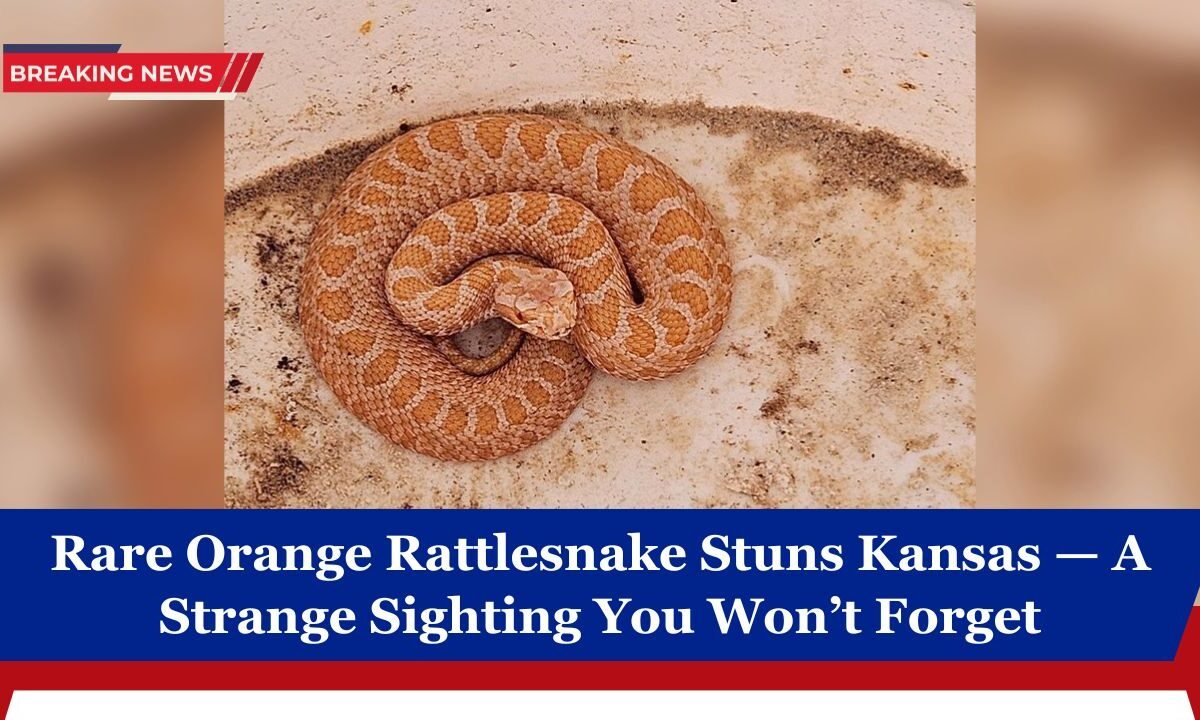When you imagine rattlesnakes in Kansas, you likely picture the typical gray or brown patterns blending into prairie landscapes.
But on October 9, in Butler County, a man spotted something truly unusual: a western massasauga rattlesnake with striking white and orange hues.
This rare coloration has wildlife enthusiasts buzzing—so let’s dive into the full story, traits, risks, and what this discovery could mean.
The Encounter: Where and When
At around 3 p.m., Stephen Chiles was walking across an industrial site about two miles west of El Dorado when he came across a snake sunning itself on a road.
He’d never before encountered a venomous snake in the wild. Instead of slithering away immediately, the snake held still—giving Chiles time to snap photos.
Realizing the location wasn’t safe for the snake, he contacted wildlife agencies to help relocate it.
What made this specimen exceptional: instead of the usual grays and browns, this snake appeared white and orange.
Experts later identified this as amelanistic coloration, not true albinism. In contrast to albinos (which lack melanin plus other pigments), amelanistic snakes lack only melanin-producing pigment cells (melanophores), so other pigment types like erythrophores and xanthophores produce red, yellow, and orange tones.
Species Profile: Western Massasauga Rattlesnake (Sistrurus tergeminus)
The western massasauga is one of only a few venomous rattlesnake species in Kansas. It’s among the smallest rattlesnakes in the state, typically growing to 18–35 inches (46–89 cm) in length.
Their usual coloration consists of gray or tan background with dark blotches. The snake has heat-sensing pit organs, a rattle, and venom—making it a pit viper species.
This species’ conservation status is delicate in many regions, and aberrant coloration specimens—those lacking normal pigment—are extremely rare in wild populations.
Because the genetic trait for amelanism is recessive, both parents must carry the gene, making the chance of offspring exhibiting the trait quite low.
Key Facts at a Glance
| Attribute | Normal Specimen | Orange / Amelanistic Specimen |
|---|---|---|
| Common Colors | Gray, brown, tan with dark blotches | White, cream, orange tones (no darker melanin shades) |
| Size Range | 18–35 in (46–89 cm) | Same general size potential |
| Coloration Cause | Normal pigment cells: melanophores, xanthophores, iridophores | Lacking melanophores (no black or brown pigment) |
| Frequency in Wild | Very common to uncommon depending on region | Extremely rare, recessive trait |
| Venomous | Yes, hemotoxic | Yes, same venom capability |
| Behavior | Nocturnal / crepuscular, basking | Same behavior likely |
Why This Sighting Matters
- Genetic Rarity
Amelanistic individuals are seldom seen in the wild because they must inherit the recessive gene from both parents. - Visibility & Predation Risk
Without darker pigments for camouflage, such snakes are more exposed—making them vulnerable to predators or accidental harm. - Conservation Implications
Finding a naturally colored-out individual can inform scientists about genetic diversity and population health. - Safety Awareness
It highlights the need for awareness: even odd-colored snakes can be dangerous. This one is venomous and should not be handled without expert training.
What You Should Do If You Encounter a Rattlesnake
- Do not attempt to handle or approach the snake—even harmlessly colored.
- Back away slowly if you come near.
- Contact local wildlife authorities with location, time, and photographs.
- Keep pets and children away.
- Leave the habitat undisturbed—wildlife professionals are best equipped to relocate safely.
The sighting of a rare orange western massasauga rattlesnake in Butler County, Kansas, is not just unusual—it’s scientifically significant.
Thanks to Chiles’ photos, wildlife officials confirmed the snake’s amelanistic traits, making it a striking exception to typical coloration. This discovery underscores the delicate balance of snake genetics, camouflage, and survival in the wild.
If you ever stumble upon a snake in Kansas—especially one that looks extraordinary—observe from a distance, stay cautious, and report it. Nature sometimes surprises us in the most unexpected shades.




